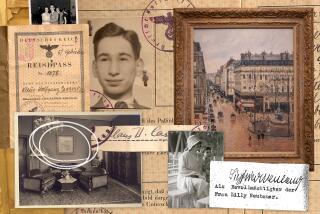Cornelius Gurlitt, hoarder of suspected Nazi art trove, dies at 81

- Share via
Cornelius Gurlitt, the reclusive octogenarian who was thrust into the international spotlight last year when it was revealed he was hoarding more than 1,000 works of art in his Munich apartment, has died. He was 81.
Gurlitt died Tuesday morning in his apartment in the Schwabing district of Munich, in the presence of a doctor, according to Stephan Holzinger, who was Gurlitt’s spokesman.
He had recently undergone heart surgery and had requested to return to his apartment following a weeklong stay at a hospital. At his apartment, he was under around-the-clock medical care.
The artwork in Gurlitt’s possession is believed to contain numerous works looted or confiscated by Nazi forces during the Holocaust. Gurlitt is the son of Hildebrand Gurlitt, an art dealer who worked with the Third Reich.
German authorities seized the works of art in 2012 from Gurlitt’s Munich apartment. Officials kept the raid secret, but a 2013 article in the German magazine Focus revealed the stash to the public.
The story became an international sensation, and put Gurlitt in the global media spotlight. The Schwabing art trove contains works on paper, paintings and other items by artists such as Henri Matisse, Pablo Picasso, Gustave Courbet, Max Beckmann and Albrecht Dürer.
Bowing to international pressure, the German government initiated an investigation into Gurlitt and the trove, and art experts began the painstaking work of authenticating the works of art.
In April, an agreement was reached between the two sides, with Gurlitt saying he would cooperate with authorities to determine which of the pieces he was holding had been seized by Nazi forces. Gurlitt agreed to return art that was linked to Nazi looting and keep pieces that are not.
Claims have already been made by families who believe some of the art was stolen from their ancestors.
Information on Gurlitt’s survivors wasn’t immediately available. His death officially ends the government’s investigation into Gurlitt, according to his spokesman.
More to Read
The biggest entertainment stories
Get our big stories about Hollywood, film, television, music, arts, culture and more right in your inbox as soon as they publish.
You may occasionally receive promotional content from the Los Angeles Times.











